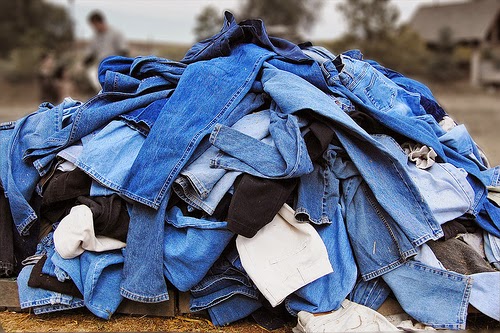 Denim Hand Scrapping:
Denim Hand Scrapping:Sand ballasting with paper, commonly known as scrapping is the most widely used process for creating the blasting effect. It is usually done by mounting the garment on rubber balloons. After mounting the garment air balloon is filled with air to expose the area to operate. It is important to fill the pressure.
Hand sand is the step which is generally being done in rigid form of garments to get the distressed look. Locations can be front thigh & back seat or its can be overall / global application as per the Standard. Emery paper is being used to scrape the garments in particular placement & design. Emery paper comes in different number generally start from 40 till 600 and above , higher the number finer the emery paper, lower the coarseness of the paper. In the garment industry from 220 , 320 & 400 number papers are most popular & widely used.
Sand blasting is the process of scrubbing off the garment by blowing high speed air mixed with very fine particles of sand. This is a very successful and most widely used process for fashion articles. When the surface area of the garment is blasted, white cotton appears beneath the blasted area and the effect is appeared very similar to the worn out jeans.
Area of Application:
Specified areas for sand blasting are front thigh, back seat, back panel near bottom or front panel around knee. Sometime full body blasting is also done for giving a unique look to fabric. Hot spots may be designed for more real look on front knees or back seat by intense blasting in these areas.
Denim Garments Hand Scraping and Sand Blasting During Washing
Posted by Firoz Kabir
1 comment
 Denim Hand Scrapping:
Denim Hand Scrapping:Sand ballasting with paper, commonly known as scrapping is the most widely used process for creating the blasting effect. It is usually done by mounting the garment on rubber balloons. After mounting the garment air balloon is filled with air to expose the area to operate. It is important to fill the pressure.
Hand sand is the step which is generally being done in rigid form of garments to get the distressed look. Locations can be front thigh & back seat or its can be overall / global application as per the Standard. Emery paper is being used to scrape the garments in particular placement & design. Emery paper comes in different number generally start from 40 till 600 and above , higher the number finer the emery paper, lower the coarseness of the paper. In the garment industry from 220 , 320 & 400 number papers are most popular & widely used.
Sand blasting is the process of scrubbing off the garment by blowing high speed air mixed with very fine particles of sand. This is a very successful and most widely used process for fashion articles. When the surface area of the garment is blasted, white cotton appears beneath the blasted area and the effect is appeared very similar to the worn out jeans.
Area of Application:
Specified areas for sand blasting are front thigh, back seat, back panel near bottom or front panel around knee. Sometime full body blasting is also done for giving a unique look to fabric. Hot spots may be designed for more real look on front knees or back seat by intense blasting in these areas.












1 comments: